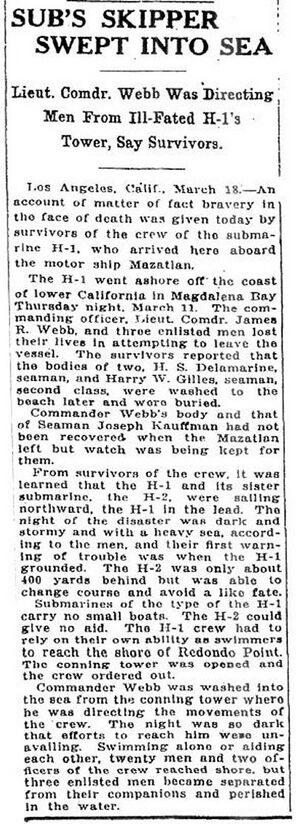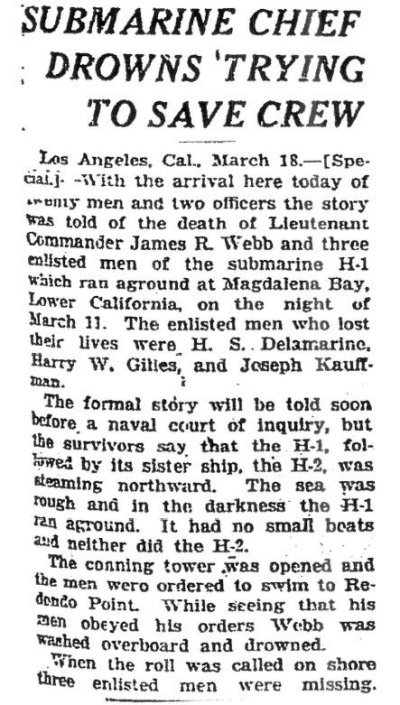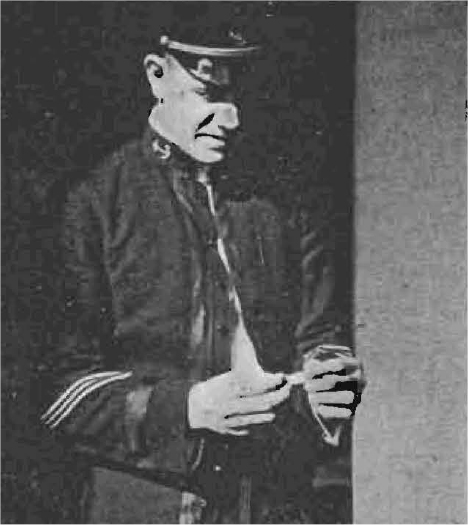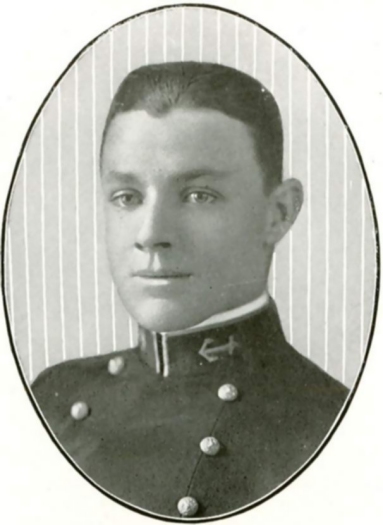H-1

Photo in the private collection of Ric Hedman.
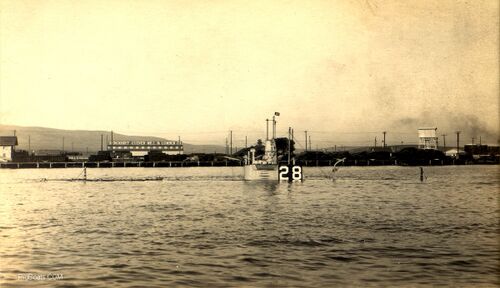
H-1 is seen here performing a stationary "static dive", bow is to the left, in the turning basin at San Pedro Harbor. The location is known due to the Kerckhoff-Cuzner Mill and Lumber Company buildings in the background. The Kerckhoff-Cuzner Company was an old established company in the greater Los Angeles area but went out of business in about 1936.
Note the helm wheel attached to the side of the periscope shears. This is a storage position. When in use it was moved to a steering hub on the pedestal with the large square head seen to the left. Chains ran below to the steering rod that ran from the control room to the rudder.
The two round "holes" are actually the deadlight windows for the conning tower. The dark rectangle below them is actually a folding deck to allow for more space for men on the bridge while surfaced. The stripes seen below that on the fairwater are actually section ribs for the conning tower. The conning tower was made up of circular sections bolted together. What you are seeing are these flanges protruding through the skin of the fairwater.
On the side of the periscope shears are seen the number 2 over 1. This means the H-1 was part of Submarine Squadron 2 and was the lead boat in that squadron. These numbers are often confused for the hull numbers. The hull number are always side by side as seen by the number 28.
Seen running up the back of #2 periscope is the piping to the ships whistle. There is an unexplained extra mast stayed to the shears and aft deck seen above the number 28.
Photo in the private collection of Ric Hedman.
Local information courtesy of Anne Hansford of the San Pedro Bay Society historical archives.

This photo was taken at Submarine Base New London. By exploring the sub's histories, it can be deduced that the photo was taken winter 1918/1919. Snow can be seen on the ground in the foreground of the photo.
The N-3 (Submarine No. 55) seen on the right arrived at New London on February 7, 1918 from Puget Sound, Washington State and remained there until June 1921. Moving left the next sub is the H-1. She arrived from San Pedro on November 8, 1917 and remained until January 6, 1920. At the next pier to the left is the H-2 (Submarine No. 29). She had identical arrival and departure dates as the H-1.
A closer look at the H-1 shows that her superstructure looks to have been removed just aft of torpedo room hatch. This would have been done to allow access to systems and components for repair. In a little more than a year the H-1 will lay a wreck in the surf at Santa Margarita Island, Baja, Mexico. Four will die in the grounding.
Next to her is the G-2 (Submarine No. 27). The G-2 was at New London from October 20, 1917 until she decommissioned on April 2, 1919. The last sub at the next pier, near the building, is the N-7 (Submarine No. 59). She was commissioned on June 15, 1918 and remained at the sub base until June 21, 1919. She traveled to Philadelphia for extensive overhaul. She returned to New London March 31, 1920 after the H-1 and H-2 had left for the Pacific.
All these dates block the time frame from between June 1918 and April 1919. With the snow, most likely time is December 1918 to February 1919. Several small craft can be seen on the river just above the pier on the right. The New London side of the river can barely be seen.
Photo in the private collection of Ric Hedman.
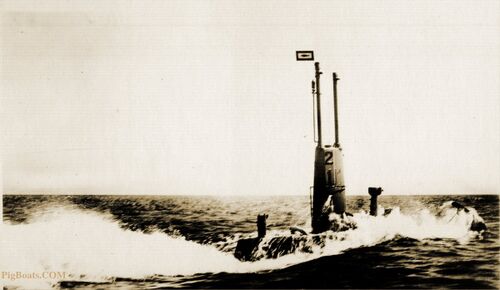
H-1 surfacing at high speed. The date and location is unknown, but is likely off the U.S. east coast in 1917-1918. Forward (right) of the periscope shears is the topside steering pedestal. The wheel has been removed to prevent possible fouling with underwater objects.
Photo in the private collection of Ric Hedman.

In late 1919, H-1, along with sister ship H-2 received orders to depart from their homeport in New London, CT. and proceed to Submarine Base San Pedro (Los Angeles), CA. for permanent duty with the Pacific Fleet. They were to be accompanied on the voyage by the patrol boat USS Eagle No. 11 (PE-11), acting as a tender. Their voyage would taken them south from New London, past Cuba, through the Panama Canal, and finally up the Mexican Pacific coast to San Pedro. It was a very long voyage for H-class submarines, and numerous stops (13 total) were made along the way for fuel, provisions, repairs, and liberty for the crews. The H-1's commanding officer, LCDR James R. Webb was the senior man among the three CO's, and thus was appointed as overall commanding officer for the small force.
On the morning of March 12, 1920 H-1 and H-2 were underway in a stiff northerly wind and current off Santa Margarita Island, itself off the coast of Baja California north of Cabo San Lucas. The Eagle No. 11 was trailing some 40 nautical miles behind. H-1, fighting the currents and wind went aground at about 01:20 am. H-2 narrowly avoiding grounding herself, and backed out to deeper water and anchored for the night. Daybreak revealed a forlorn sight on the beach. H-1 was hard aground on the sandy beach, heeled over to starboard.
Immediately upon grounding, Webb made several attempts to get the boat off the sand, but they were stymied and they wound up broadside to the beach. Waves began to break over the boat and knowing the situation was hopeless, Webb ordered the boat abandonded. Unfortunately, Webb was washed over the side and lost in the surf. In the process of getting the crew to the beach, three other men perished, MM 1c Harvey W. Giles, Seaman William H. Delamain, and Seaman Joseph Kosman. The remainder of the men were eventually rescued and repatriated to San Pedro. Delamain and Giles were buried on the beach near the wreck of the H-1, the bodies of Webb and Kosman were never recovered. See Dr. Richard Hendren's excellent doctoral thesis on the H-1, her loss, and the archeology of her wreck site at this link.
Photo in the private collection of Ric Hedman.

A crew member reflects on the sacrifice of his shipmates as he stands over the makeshift graves on the beach for Seaman William H. Delamain (left), and MM 1c Harvey W. Giles, (right). Santa Margarita Island, Baja California, Mexico, March 1920. The bodies were recovered by the Navy and returned to the United States for burial.
Photo in the private collection of Ric Hedman.
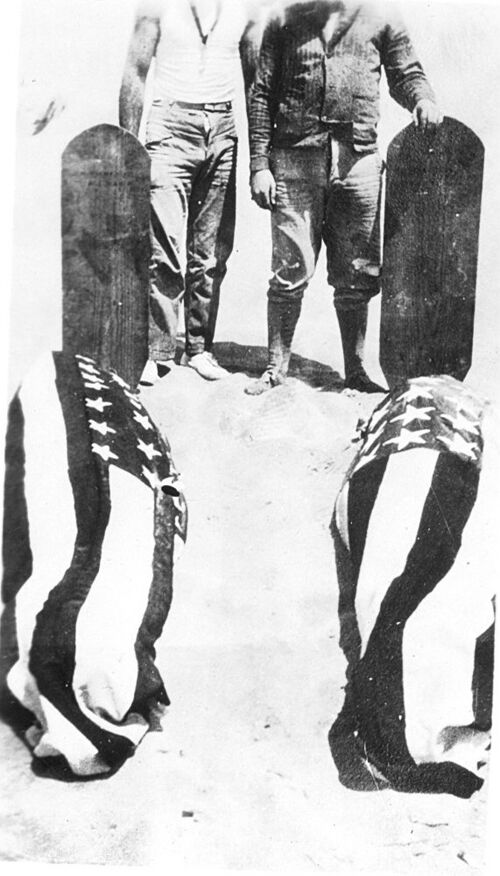
Bodies of the two the men recovered are draped in U.S. Flags. This may have been as the bodies were being disinterred for return to the U.S. It is interesting to note the difference in the two flags. On the left is a 48-star flag and on the right is a 13-star naval ensign. Shown are the bodies of Seaman William H. Delamain (left) and MM 1c Harvey W. Giles (right).
Photo in the private collection of Ric Hedman.
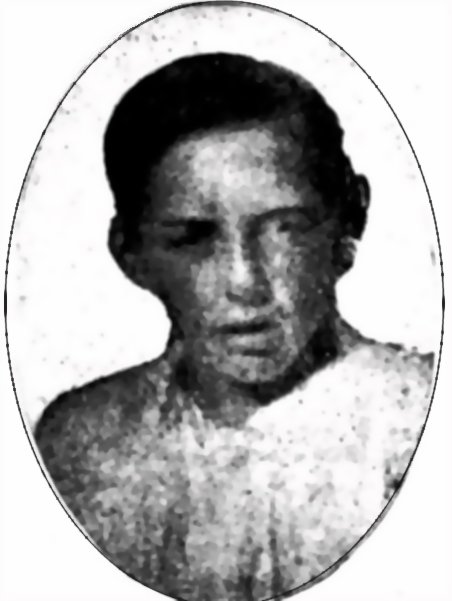
William H. Delamain. Born May 22, 1901, Died March 12, 1920. His body was subsequently returned to College Point, NY and on April 8th, 1920 interred in the family plot in Cedar Grove Cemetery in Flushing, Queens, New York. Seaman William H. Delamain was just a few weeks shy of his 19th birthday when he died. For more information please see Ric Hedman's and James Haas' article on Delamain at this link.
Photo in the private collection of James Haas.
U.S. Naval Academy photos, courtesy of James Haas.
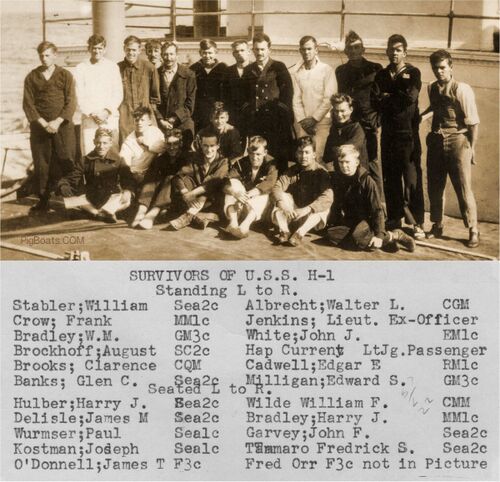
A photo taken of the rescued crew of the beached and wrecked submarine USS H-1. The photo is most likely taken aboard the civilian ship MV Mazatlan that discovered the crew several miles north of the wreck site some fifteen hours after the grounding. The location was noted as a small cove near "White Bluffs".
The MV Mazatlan was a steel freight and passenger ship of 967 gross tons and 165 feet long with a speed of about 8 knots. The vessel was owned by the California & Mexico Steamship Company and traveled from San Francisco and Los Angeles to West Coast Lower California and Mexico.
There are some issues with the crew listing. The name second from the bottom in the left column says "Kostman; Joseph Sea1c", Joseph Kos(t)man Seaman 1c was reported washed overboard and never found. Was there really a Kostman and a Kosman, both named Joseph and both rated as Seaman 1c aboard a ship this small? Plus, if you count the men there are 21 of them but if you count the names there are 22 of them. I believe Kostman was added in error.
Photo contributed by Darryl Baker from the files of the Vallejo Naval & Historical Museum, file # H 1 3164-1.

This and the next several photos were taken during the attempts to pull the H-1 off the beach. This shows what is likely an inspection team going aboard on March 21, 1920 in an attempt to ascertain the condition of the boat. The repair ship USS Vestal (AR-4), the flagship of the salvage force, can be seen to the right. On the left is likely the fleet tug USS Sonoma (AT-12).
Photo in the private collection of Ric Hedman.
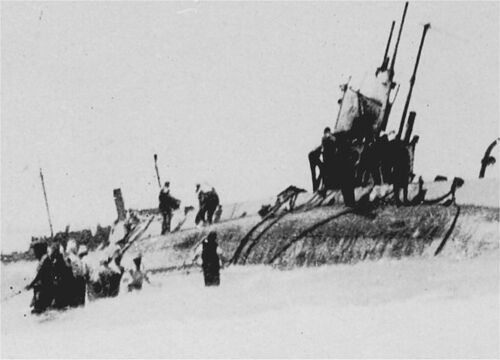
Once the team got onboard they found that a fire had started in the forward battery and had essentially gutted the forward battery and control room, and heavily damaged the interior of the torpedo room. The hull was fairly sound though. Unfortunately it was found that locals had entered the boat in the interim and ransacked it, making off with virtually anything of value, including forcing open the safe. Only the torpedoes remained.
Photo in the private collection of Ric Hedman.
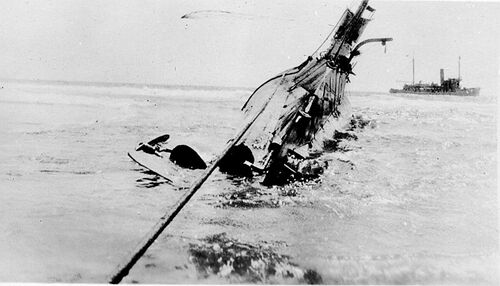
A view from H-1's stern as the salvage force was preparing to pull it off the beach. The fleet tug USS Sonoma (AT-12) is in the background, preparing her towing gear.
Photo in the private collection of Ric Hedman.
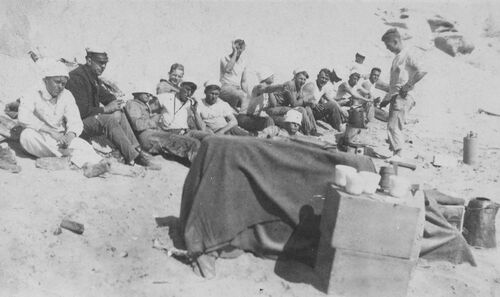
A working party was sent ashore from the Vestal to assist in the salvage process. They are shown here taking a break on the beach.
Photo in the private collection of Larry Vredenburgh.
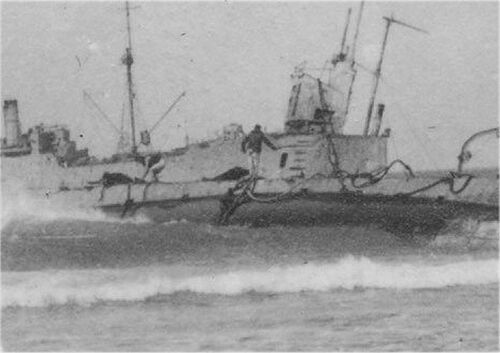
The working party went aboard to rig the towing bridle. The Vestal was periously close to shore and is just off the H-1 starboard bow.
Photo in the private collection of Larry Vredenburgh.

This shows the Vestal's shore crew tending to a cork raft used to ferry the towing bridle to the H-1, March 22, 1920.
Photo in the private collection of Larry Vredenburgh.
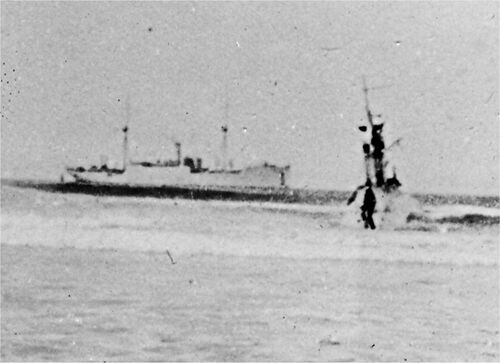
The Vestal is seen to the left of the H-1 as the Sonoma slowly pulled the submarine into deeper water.
Photo in the private collection of Ric Hedman.
Newspaper clipping courtesy of James Haas.

The wreck of the H-1 currently rests on its port side in approximately 60 feet (10 fathoms or 18.2 m) of water just off shore with its bow pointing northwest. It has been visited on at least three occasions and has been thoroughly surveyed. Large portions of the wreck have been lost to galvanic corrosion, but the relatively benign weather conditions in the area have left the wreck well consolidated.
This photo shows the 2016 expedition dive team taking measurements of the stern of the boat.
Photo copyright Alfredo Martinez Fernandez. Used with permission.

Another view of the 2016 dive team taking measurements of the propellers.
Photo copyright Alfredo Martinez Fernandez. Used with permission.

This is a broad view of the wreck from above, with the stern to the bottom of the photo. The keel is to the right. Most of the hull plating covering the after battery, control room, forward battery, and torpedo room has corroded away. The conning tower fairwater can barely be seen in the upper center of the photo. It is in surprisingly good shape.
Photo copyright Alfredo Martinez Fernandez. Used with permission.

A view looking aft from the area of the torpedo room bulkhead. The top half of the pressure hull should be to the right, but it has almost totally corroded away. The two divers are very near the conning tower fairwater.
Photo copyright Alfredo Martinez Fernandez. Used with permission.

A view similar to the one above, from a different angle.
Photo copyright Alfredo Martinez Fernandez. Used with permission.

A view from above, with the stern to the top of the photo. Water conditions are obscuring the stern and the bow of the wreck. Only the center section is visible.
Photo copyright Alfredo Martinez Fernandez. Used with permission.

This view is looking aft at the forward battery well bulkhead. The keel is at the bottom, and the starboard side bilge keel is at the top.
Photo copyright Alfredo Martinez Fernandez. Used with permission.

Almost the entirety of the torpedo room is gone. Only the forward section with the tubes and the bow cap remain, barely connected to the remainder of the wreck by the keel. This photo shows a diver swimming aft along what would have been the torpedo room bilge. The bulkhead for the forward battery well is in the background.
Photo copyright Alfredo Martinez Fernandez. Used with permission.
Page created by:
Ric Hedman & David Johnston
1999 - 2023 - PigBoats.COM©
Mountlake Terrace, WA, Norfolk, VA
webmaster at pigboats dot com

